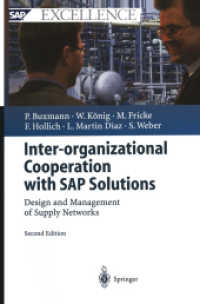- ホーム
- > 洋書
- > 英文書
- > Business / Economics
Full Description
Innovation and entrepreneurship have always had a strong and synergistic relationship. While Design Thinking and the Lean Startup have emerged as popular methodologies for managing innovation and entrepreneurial endeavours, the time is ripe for a rethinking of the innovation approach by going back to core principles.
By considering the strengths and weaknesses of Design Thinking and the Lean Startup within their respective contexts, expert David C. Roach revisits the fundamentals of innovation management. Addressing the cultural gap between STEM and business perspectives, Roach emphasizes the importance of managing the front-end of innovation, where the most critical decisions are made, and concepts shaped. Demonstrating how Design Thinking's enthusiasm for observational research can be particularly useful, while the Lean Startup's passion for hypothesis-driven minimum viable product (MVP) testing is a clear strength, Roach argues that the success of innovation depends on a robust concept coupled with a realistic business model.
The Innovation Approach: Overcoming the Limitations of Design Thinking and the Lean Startup challenges the notion that brainstorming or constant pivoting can solve all problems. It demonstrates that when aspects of both these methodologies are embedded in a structurally sound innovation management approach, the results can be world-class.
Contents
Section I. Introduction
Chapter 1. Systems of Innovation
Chapter 2. Limitations of Design Thinking and the Lean Startup
Chapter 3. A Complimentary Model of Innovation Management
Section II. Core Steps and Capabilities
Chapter 4. Secondary Research
Chapter 5. Benchmarking
Chapter 6. Primary Research
Chapter 7. Concept Development
Chapter 8. Concept Evaluation and the MVP
Section III. Advanced Tools and Techniques
Chapter 9. Adoption Theory in Practice
Chapter 10. Learning from Lead Users
Chapter 11. Sustainability
Section IV. System Level Capabilities
Chapter 12. Team Selection, Structure and Governance
Chapter 13. Project Management Essentials
Chapter 14. Heuristic Business Modeling








